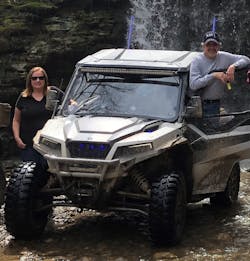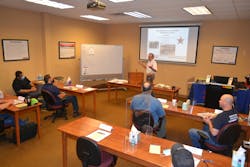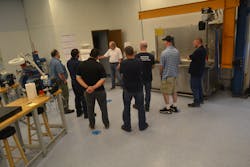By Karen Hanna
Documentation and maintenance are in Steve Johnson’s genes.
His father — a man so gifted at all things mechanical he built his town’s fire truck from spare parts — taught him to wrap notes around parts, so he’d know how they all worked together later. Many years later, that lesson bore fruit, in the development of MoldTrax Maintenance Solutions — a software system that injection molding companies now use to track issues with molds.
In a conversation with Plastics Machinery & Manufacturing Senior Staff Reporter Karen Hanna, Johnson talked about how his father’s approach to maintenance, as well as his own experience working on A4-L Skyhawk jets during a stint in the U.S. Navy, helped turn him into an evangelist for proactive maintenance and careful note-taking.
Johnson: Well, it was purely out of necessity. When I got out of the Navy, I was looking for a job, and just got lucky with Calmar, which had just opened in Washington Court House [Ohio], my hometown. That was the first time I had been associated with plastics or injection molds. I had to learn how to weld and grind. You had to be pretty competent at multiple trades to do everything that was required during a PM [preventive maintenance] or a breakdown. We had stack tools and rack molds, and hundreds and hundreds of pieces and parts. You have to establish a system and a procedure to keep yourself and the mold safe, and to reduce mistakes.
How did your four years of active duty in the Navy prepare you?
Johnson: They reinforced a couple of things ... from the way that I grew up with my father, because we were a very mechanical family. Especially with jets, they pounded into me that maintenance is a process. You have to have faith in the process; you [need] discipline to follow these procedures. If we all do our jobs and follow the manual and do it right, jets will fly and complete the mission.
Tell me about your father.
Johnson: He was kind of a jack of all trades. He sold real estate, he sold farms. We were flipping houses before it was a fad. He was mayor for a while. He built the first fire truck they ever had, using parts from a hardware store and junk cars.
We all had to work on our own stuff. We mowed lawns at an early age. If our lawnmowers broke down, we had to repair them. Bicycles, anything like that mechanical, we couldn’t afford to go buy new; we had to maintain them.
We also worked on hit-and-miss engines. They’re some of the first gasoline engines that were mobile, built back in the early 1900s. Basically 1 to 5 horsepower, and they pulled them around on carts to power water pumps to grind corn or whatever. My dad collected those, and we rebuilt them as kids. That’s where I cut my teeth on beginning to take things apart with a lot of components to them. They [could be] full of rust, and you had to be very careful, because if you broke [one] trying to over-tighten it or loosen something, you could be in trouble because, obviously, you can’t buy the parts anymore.
He would have us take these pieces apart and write down on a piece of paper what they are, and then wrap the paper around [them] and put a rubber band around [them], so when we put it back together and cleaned it, we knew what it was for.
That stuck with me when I developed MoldTrax.
You were at Calmar when you started working on MoldTrax. How did that come about?
Johnson: When I started there, I was used to working with a military manual that was very clear and concise; they had pictures, good explanations. My first day [at Calmar], they gave me a hot-runner tool and said, “Here it is. Fix it,” and I said, “OK, do you have a manual?” They laughed at me. They said, “You want a manual? Here’s your manual.” They threw me this old, big, thick beat-up logbook that was like a diary, and people could write in there whatever they wanted. I [could] see where a guy spent three days, five days and spent $15,000 to repair [a tool]. But when it came time for an explanation of what he actually did, all he wrote was, “Fixed it.”
I'm thinking, “Gosh, this is pretty weak. People need more than this.”
I started keeping sticky notes on everything that I worked on. I would come into work in the morning, and the sticky notes are drying up, and every day I come in, there’s 15 of them lying on the floor.
I’m thinking, “Man, this is really good information. I wish I had some kind of a system [for it].”
My nephew was a software technician, and he introduced me to a developer. And for the next five years, every Friday after work, I would drive in to Columbus and I would take these notes [to him]. And he developed the initial MoldTrax program.
Johnson: I was an hourly guy, and we had tooling engineers that used a large ERP system for our mold maintenance work orders, and they were not interested in changing anything up. So I copyrighted my program, and just continued to grow the system. I also wrote an article about establishing a proactive [mold maintenance] culture versus a firefighting culture.
Through that article, I got a side job from a consulting company called TechTrax. They called me up and said, “Why don’t you put together a two-hour session?” They flew me to Detroit. Thirty-five or 40 people signed up for it; it went over really well. [TechTrax] said, “We want you to make this a half-day [session].” So, I made it a half-day, then eventually eight hours and eventually a two-day deal. And they're flying me around the United States. And at every stop, they would find a plastic company that would let us tour. That’s when my eyes were opened that all these different companies needed better documentation.
How did you launch MoldTrax as a business?
Johnson: I stayed at Calmar for 22 years as a tool maker. After I left there, I went to work for Abbott Labs for eight years as a maintenance engineer and continued to grow and market MoldTrax.
I had been reading all the trade magazines, and I’d seen ToolingDocs pop up now and then. They were basically just a website. If you had a question about maintenance, you would go to that website, type in your question, and one of their salespeople would answer.
I popped in there. I said, “If you ever need any help answering some of these questions, let me know.” A couple days later, [then ToolingDocs owner] Glenn Starkey called me. [Later] he said, “If Abbott ever closes, give me a call.”
When Abbott shut down [in Ashland], I had the opportunity to either move to Buffalo or Chicago, and I didn’t want to do either one of those, so I got a hold of Glenn, and we had a discussion, then he hired me to run [the ToolingDocs] division. I couldn’t ask for a better job in the world for me, than being asked to come and run ToolingDocs.
Eventually, you merged MoldTrax and ToolingDocs, so you now do training. Tell me about that.
Johnson: After I started to work for ToolingDocs, we needed a facility to do hands-on work [for training sessions.]
We built what we consider a state-of-the art mold maintenance facility, where our business model would be 80 percent actual maintenance and repair work on molds around our area and the other 20 percent of the business being instruction/training. Unfortunately, we opened our doors at the beginning of the [Great] Recession. So, I called our customers and said, “Hey, we’re ready.” They said, “Nope, sorry, we don’t have any molds. Half our staff is laid off.”
A few weeks later, the same people are saying, “We’re bringing in some new people. Do you have any courses where you can show them how to work on molds?”
I created the STAR program where we have five factors of continuous improvement, and one of the five factors is documentation. That’s where MoldTrax comes into play. You need a system like MoldTrax to measure specific metrics to determine what areas need the most improvement so you can focus on these. [The other points of emphasis are leadership, maintenance strategy, shop design and shop skills.]
I also developed a Maintenance Capability Assessment program to audit repair shops. It is a 95-page document that guides us through this audit. We look at the documentation, what they’re collecting, who’s using it. We look at their shop: What kind of cleaning technology do they have? How’s their lighting, their bench layout?
Unfortunately, most don’t score well, but then that’s why we are there. After scoring, we create a customized plan to address the areas needing improvement.
What advice do you give companies that have mold shops?
Johnson: Everybody needs to do a better job understanding the performance and maintenance characteristics of their molds.
[People] run [a mold] till it leaks, squeaks or breaks. There are a lot of reasons that we shut down molds, but there are only two categories: It’s either a scheduled stop, or it’s not. And those unscheduled mold stops cost companies, in many cases, literally millions of dollars a year in unscheduled breakdowns.
Yet, when we ask companies, “You’re spending two and a half million dollars a year on unscheduled mold stops; can you tell me what your No. 1 unscheduled mold stop is?” Ninety-nine-point-nine percent of the time, they’ll say, “No.”
We’ve had companies that are spending $5-10 million a year on unscheduled stops. They don’t know what their top 10 are, let alone their No. 1. They don’t keep good records. They don’t track the right data, and the reason they don’t track the right data is because they’re still using journal entries in their maintenance work orders.
The whole key in keeping accurate records is to be able to use standard terminology. We’ve been doing this long enough that we can say to people, “If you don’t standardize your language and create reports that allow you to actually measure metrics in the Star System, you will never improve.”
Any success stories?
Johnson: We’ve had a lot of success stories with people who have bought into our system of work or methodology, through standardization and running reports.
For the last two years, we’ve been working with a medical device company [whose] goal in life is to be the most technologically advanced molding company on the globe. They had 30 locations keeping records in some form of a log entry or another, so we put MoldTrax in all locations. It’s so difficult to get people to standardize terminology just at one facility; [the company] is doing it within [all its] locations around the globe. They’re already saving millions of dollars a year, because they’re able to run reports and see, “What was my worst-running tool last year based upon tooling costs, labor, unscheduled stops or defective products?”
What’s holding people back?
Johnson: Everybody that we talk to agrees that they need to get better. They need to get more efficient at maintenance. But they just don’t know where to start. To be more effective, we have to have the tooling people and process people on the same team; they have to be able to communicate. Also most companies have never had usable data — data that goes beyond a log book or work order entry so this type [of] data is new to people.
We teach and practice Reliability-Centered Maintenance. That’s a different type of strategy, where you monitor failure modes. You need to understand what modes are giving you the most issues.
What would you say to someone else who is toying with an idea that, like yours, doesn’t seem to find acceptance?
Johnson: I would tell him, “Don’t lose faith, if you know what works for you, and you think you’ve got a good idea. Don’t lose faith in it, and try to do more investigation, and get a feel for the industry. Does it work for you? Or does it really work for the masses?”
What do you like to do in your spare time?
Johnson: Right now, our family is into [utility task vehicles (UTVs)]. I have a Polaris side-by-side.
We also still like to throw axes. I have a target set in in my back yard, so, when the kids and grandkids come over, we build a giant bonfire and throw axes, hatchets, knives and about anything that will stick.
I got bored with mold maintenance after a while, so I took up cabinet-making. I’ve built a ton of furniture. I have built a ton of furniture for clients.
I built a tool chest for my work. It was featured in Fine WoodWorking magazine.
We still like to rebuild old engines. I spent five years timber-framing a barn. Before I could get it entirely assembled, I moved up here to Ashland; so, I disassembled it and then moved all the pieces up here. I’ve got them all stacked up and want to reassemble them here. There’s no nails to hold the barn together; you just cut big beams out of trees, and then you hand-chop a mortise and tenon, and then you put the mortise in the tenon, and you drill a hole and run a pin through it.
What do you see as your legacy?
Johnson: I think I have brought more focus to the importance of maintenance and demonstrated through our courses [that] there is a huge potential for lowering maintenance costs and allowing molds to run better and longer. Through MoldTrax, through our courses, I think we’ve done a good job showing people that maintenance is a process. It needs to be done correctly. The whole thing is bringing [maintenance] out of the dark ages.
Karen Hanna, senior staff reporter
Just the Facts
WHO IS HE: Steve Johnson, owner of MoldTrax LLC, which works with contractors to provide services to molders.
ESTABLISHED: 1998. MoldTrax expanded in 2016, when Johnson bought ToolingDocs’ assets, as well as licenses to its courses from owner Starkey
LOCATION: Ashland, Ohio
ACHIEVEMENTS: 1978 Stihl Lumberjack competition Ohio State Axe Throwing champion; 2014 SPE Mold Designer of the Year
AGE: 68
About the Author
Karen Hanna
Senior Staff Reporter
Senior Staff Reporter Karen Hanna covers injection molding, molds and tooling, processors, workforce and other topics, and writes features including In Other Words and Problem Solved for Plastics Machinery & Manufacturing, Plastics Recycling and The Journal of Blow Molding. She has more than 15 years of experience in daily and magazine journalism.


